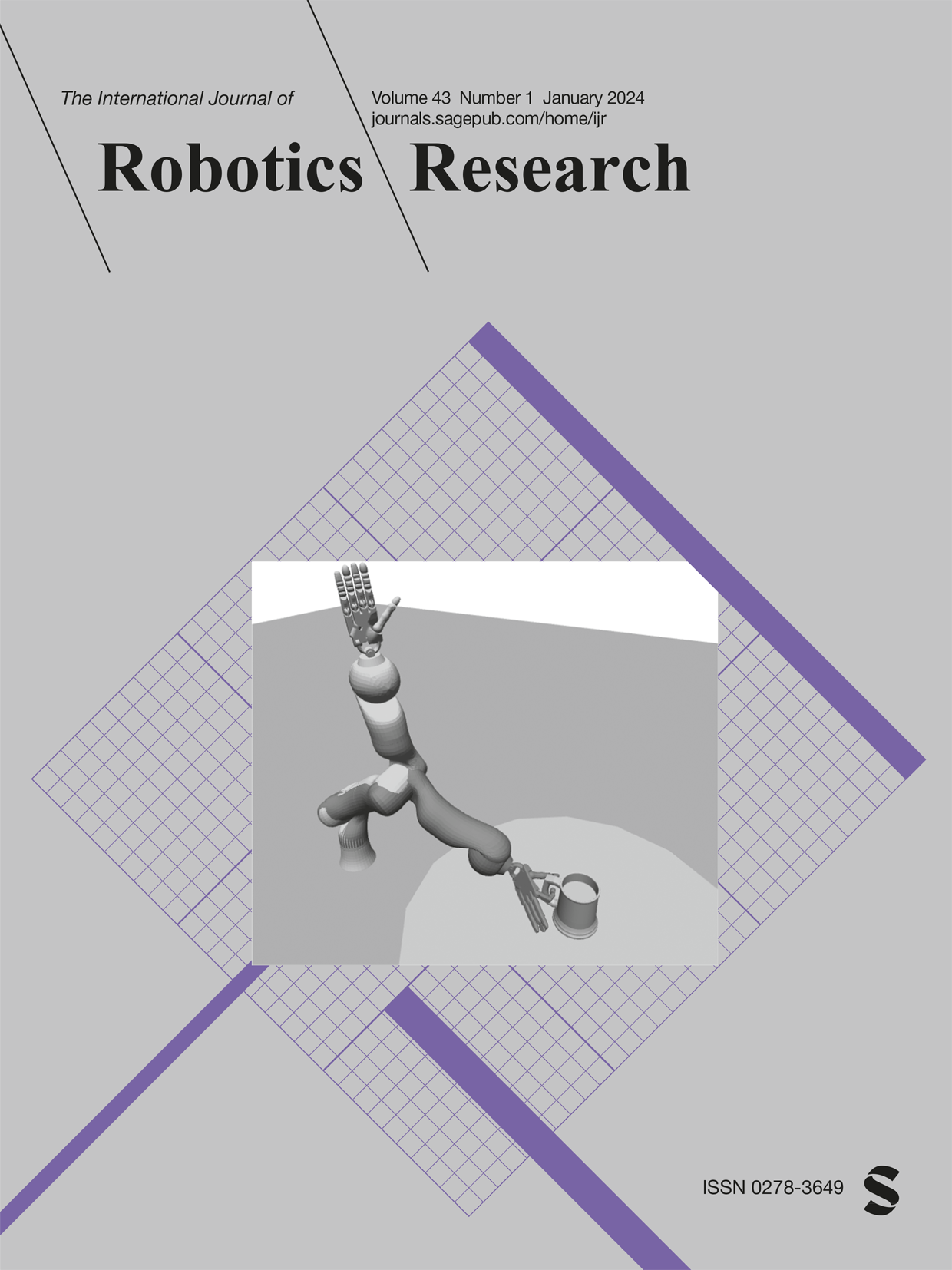通过可重构欠驱动的系统对象不变在手操作:介绍RUTH夹具
IF 7.5
1区 计算机科学
Q1 ROBOTICS
引用次数: 10
摘要
我们介绍了一种可重构的欠驱动机械手,无论物体大小或形状如何,都能进行系统的手内抓握操作。手部采用两自由度五杆联动装置作为夹持器的手掌,三个三指骨欠驱动的手指由单个致动器共同控制,连接到手掌的可移动旋转关节。在机械手系统中总共使用了三个致动器,一个用于控制手指通过欠驱动肌腱系统施加在物体上的力,两个用于改变手掌的配置,从而改变手指的位置。这种新颖的布局允许抓取和操纵解耦,便于手部操纵操作的规划和执行。可重新配置的手掌为手提供了很大的抓握通用性,并允许基于基于距离的连杆运动学轻松计算任务空间和关节空间之间的映射以进行操纵。不同大小和形状的物体从一个姿势到另一个姿势的运动是直接和系统的,前提是要抓住物体。这是由使用自定义肌腱布线方法的欠驱动手指独立和被动地保证的,当相对手指底部位置随着手掌重新配置而变化时,该方法不允许肌腱长度变化。我们分析了手的理论抓握工作空间和抓握和操纵能力,提出了计算操纵图和手内操纵计划的算法,并对所有这些进行了实验评估。对不同大小和形状物体的几种操纵轨迹的数值和经验结果清楚地证明了所提出概念的可行性。本文章由计算机程序翻译,如有差异,请以英文原文为准。
Systematic object-invariant in-hand manipulation via reconfigurable underactuation: Introducing the RUTH gripper
We introduce a reconfigurable underactuated robot hand able to perform systematic prehensile in-hand manipulations regardless of object size or shape. The hand utilizes a two-degree-of-freedom five-bar linkage as the palm of the gripper, with three three-phalanx underactuated fingers, jointly controlled by a single actuator, connected to the mobile revolute joints of the palm. Three actuators are used in the robot hand system in total, one for controlling the force exerted on objects by the fingers through an underactuated tendon system, and two for changing the configuration of the palm and, thus, the positioning of the fingers. This novel layout allows decoupling grasping and manipulation, facilitating the planning and execution of in-hand manipulation operations. The reconfigurable palm provides the hand with a large grasping versatility, and allows easy computation of a map between task space and joint space for manipulation based on distance-based linkage kinematics. The motion of objects of different sizes and shapes from one pose to another is then straightforward and systematic, provided the objects are kept grasped. This is guaranteed independently and passively by the underactuated fingers using a custom tendon routing method, which allows no tendon length variation when the relative finger base positions change with palm reconfigurations. We analyze the theoretical grasping workspace and grasping and manipulation capability of the hand, present algorithms for computing the manipulation map and in-hand manipulation planning, and evaluate all these experimentally. Numerical and empirical results of several manipulation trajectories with objects of different size and shape clearly demonstrate the viability of the proposed concept.
求助全文
通过发布文献求助,成功后即可免费获取论文全文。
去求助
来源期刊
CiteScore
22.20
自引率
0.00%
发文量
34
审稿时长
6-12 weeks
期刊介绍:
The International Journal of Robotics Research (IJRR) has been a leading peer-reviewed publication in the field for over two decades. It holds the distinction of being the first scholarly journal dedicated to robotics research.
IJRR presents cutting-edge and thought-provoking original research papers, articles, and reviews that delve into groundbreaking trends, technical advancements, and theoretical developments in robotics. Renowned scholars and practitioners contribute to its content, offering their expertise and insights. This journal covers a wide range of topics, going beyond narrow technical advancements to encompass various aspects of robotics.
The primary aim of IJRR is to publish work that has lasting value for the scientific and technological advancement of the field. Only original, robust, and practical research that can serve as a foundation for further progress is considered for publication. The focus is on producing content that will remain valuable and relevant over time.
In summary, IJRR stands as a prestigious publication that drives innovation and knowledge in robotics research.

 求助内容:
求助内容: 应助结果提醒方式:
应助结果提醒方式:


